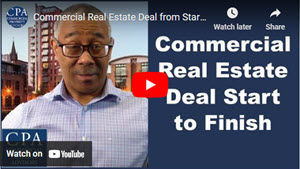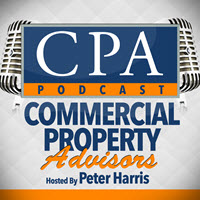
If you’re in your 40s, 50s, 60s, or even 70s, and you have money in your retirement accounts, you ought to be asking yourself this question. Is my retirement portfolio growing and generating enough cashflow that I can retire comfortably and not run out of money before I pass away? In this article I will outline the advantages of investing in commercial real estate and how to maximize your retirement investments.
When you were younger investing in mutual funds and stocks was fine, but now it is too risky. You need something tangible, something you can control. A whole other universe is out there besides stocks and mutual funds. It’s called commercial property investing. If done well and if you can wait long enough, you can get 10% to 30% percent ROI returns, or even 100% return on investment. You don’t have settle for low returns.
Five Pillars to Maximize Retirement Investments
In order to maximize your retirement investments, you need these five things:
- Control
- Cashflow
- Growth in value
- Safety
- Being tax friendly
Control of the Cashflow: In commercial property we can raise our rates, reduce our expenses, and produce more cashflow on the spot. Can you do this with mutual funds and stock?
Growth in Value: Did you know that in commercial real estate as the net operating income goes up so does the property value? We can force the property value upward to the extent that we can refinance that increased equity and pull out our down payment. Then we do a cash out refinance, put it in our pocket tax free, and keep the profitable property. You can’t do this with stock and mutual funds, but you can if you have control over your investment.
Safety: When investing in commercial real estate you have predictability because you have control over when things happen. You have control over the management; you can hire and fire anyone you like. If you have mutual funds, you don’t have control over this since it’s the responsibility of the shareholders.
Tax Friendly: If you have a commercial property you can do what is called cost segregation. For instance, if you have an eleven-unit apartment building and it has 11 air conditioners or 11 new refrigerators, you can rapidly accelerate the depreciation of those products. Over five years it is possible to write off all the refrigerators, all the air conditioners and all the other fixtures. That is hidden cashflow in your pocket during tax time at the end of the year. Cost segregation, also called chattel depreciation, is a powerful strategy when you control your real estate but isn’t possible with a stock or mutual funds.
Meet Kathy
I have a student named Kathy and she has a problem. Although she has a substantial amount of money in her retirement portfolio, it’s not growing. She feels nervous spending it because she isn’t confident that it will last her entire life. She came to me and hired me as her mentor. I had her take out 15 percent of her retirement account and invest in commercial real estate. When she first came to me, I wanted to show her the advantages of investing in commercial real estate as opposed to investing with stocks and mutual funds.
Benefits of Commercial Investing
- She is getting cashflow that she can spend confidently, continually and comfortably for many years. There is increase in the value of her property. She will not lose principle and she will not run out of money.
- Her commercial real estate purchase will be safe compared to stocks and mutual funds. In commercial real estate we have predictability. When interest rates rise, or whenever something happens in the market, I know what to do because I’m an expert in commercial real estate investing and have been in this business a long time.
- It is tax friendly. Each month Kathy will put money in her pocket that she can spend on bills. At the end of the calendar year there should be no income tax to pay because of all the write offs and legal tax loopholes she has as a commercial real estate investor.
- Most importantly, Kathy will have control of her property. You do not have control over your stocks and mutual funds. Kathy has control over the property, where no bad news in the press, no politics and no corporate corruption can take away her worth or her cashflow.
Kathy’s Deal
Using a commercial realtor, Kathy is buying a 16-unit apartment complex. Her purchase price is $640,000 and she’s buying it in an 8% cap rate area. (If you want to make the wisest decisions you need to be aware of what the market cap rate is in your area.) She is putting down 25% of $640,000, which is $160,000. Her rents are under market, meaning that we can raise the rents. The building requires some work and is in average condition.
Can you find a deal like this? Of course, you can. However, Kathy established a great relationship with her agent, and it required her looking at forty deals with us to find this one. It takes time and concentrated effort, but she found this one through an agent, so these deals are on the market.
Below I have her deal numbers broken down for you. First I have her current numbers, the actual numbers related to her investment as they are now. I have also included the predicted numbers, which represent the goals we are aiming to meet in about two years. I know two years is a long time, but I’ll show you that it’s worth it.
Current Numbers
Her rental income per year is $90,000. Since she isn’t going to be 100% full for the entire 12 months, I’m going to subtract a 5% vacancy factor of $4,500. This gives me an effective gross income of $85,500.
I’m going to subtract her operating costs of $32,142; including property management, insurance, taxes and repairs. That is going to leave me with an NOI (income minus expenses) of $53,358.
From there I’m going to subtract her annual mortgage amount of $30,912. That’s based upon her putting down 25%, a 5% interest rate and a 30 year amortization.
The NOI minus the mortgage equals the cashflow. Her cashflow Is $22,446 or $1,870 per month. She ends up with a 16% cash on cash return and an 8.3% cap rate. Now, this 8.3% is slightly above the market cap rate, so she’s slightly overpaying for the house. However, in markets today it’s okay, especially in this case, as you will see.
Projected Numbers
Our two-year plan is to raise her rents $125 per unit. As the tenants move out, we are going spend about $3,000 per unit in upgrades, and then we are going to raise the rent $125 more. That’s going to give us a new income of $114,000 over the next couple years. I’m going to take out my 5% vacancy factor of $5,700 and what is left is $108,300.
We have the same expenses of $32,142. I’m going to subtract the expenses from my income. That gives me a new NOI of $76,158 and an increase of about $23,000. That is key since as the NOI goes up so does the house value, and it’s one of the reasons why we slightly overpaid.
The NOI minus the mortgage of $30,912, gives us a new cashflow of $45,246. Raising the rents $125 over the next two years on 16 units doubles our cashflow. This gives her a monthly cashflow of $3,770 a month, 32% cash on cash, along with the cap rate comes out to 11.8%. Here you can see the significance of purchasing more units.
Does this property meet the five pillars to maximize your retirement investments?
Control
Does Kathy have control over this property? She sure does. She purchased it herself and nobody forced her into it. She is in control of the management and she’s watching the numbers. She has full control over this asset.
Cashflow
She’s walking in with cashflow and then she doubles her cashflow in two years. Every year she’s going to make this until she raises the rent. It is consistent and it will continue to climb. Can you say the same with your shares and mutual funds?
Growth
Kathy came to us because she was not experiencing growth in value in her portfolio account. In fact, it was in decline. We had her purchase this property to show her that it can grow. You may need to read some of my other blogs to fully understand this concept but allow me to explain it.
Commercial Cash Out Refinance: If you take your future NOI and you divide it by your market cap rate area, that’s going to give you your new property value. Kathy’s projected NOI of $76,158, divided by 8% gives her a new property value of $951,975. She bought it for $640,000, but through the process of increasing the rents, maintain the expenses and boosting up the NOI, we increased the property value from $640,000 to $950,000. Then she can do a cash out refinance. She can go back to the bank, show the banker her new numbers, pull out her original down payment and keep her cash flowing property.
Security, Predictability and Management
Kathy hired the very best management in the region. She has full control employing and overseeing them. As a mentor, I show our students how to handle the management, which is important.
Tax Friendly
To me something that is tax friendly simply means that there are no income taxes to be paid at the end of the year. Her cashflow is $22,000. Her mortgage is $30,000 a year and $20,000 of that is interest she can write off. There is also $10,000 in depreciation she can write off as well. Together with all the legal tax loopholes and the write offs, she can write off that $30, 000 against the $22,000, so she is paying no taxes the first year.
Next Steps to Maximize Your Retirement Investments
Ask yourself this question: is my retirement portfolio performing in such a way that I can spend money and still have the value in my retirement account grow? If the answer is no, then you need to get educated because no one cares about your money more than you do. Your investment advisor who handles your retirement account is educated in what they do, but you need to decide if you want to put your investments in the hands of someone else or do you want to take control of it yourself?
The final step is to get in touch with me. I’m here to help, serve and listen. We can talk about what you have going on with your retirement portfolio. I can help you add something to it and maximize your retirement investments.



